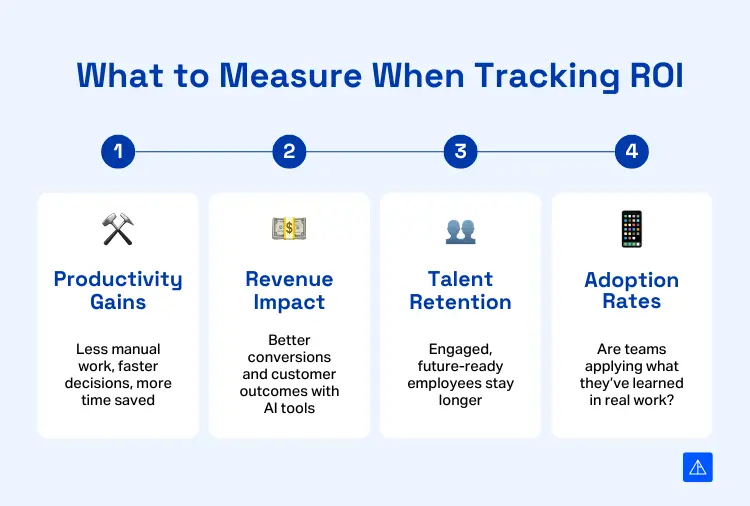As AI adoption scales across industries, the pressure is on HR and leadership to turn capability gaps into strategic advantages. But, like any investment, the challenge lies in proving its worth. Measuring the ROI of AI isn’t just about tracking training completions—it’s about understanding how upskilling can:
💡 Transforms day-to-day operations
📊 Enables faster, more accurate decision-making
🙋♂️ Improves talent engagement and retention
📈 Contributes directly to business growth
Qualified AI training has become one of the most straightforward ways for companies to build resilience and stay competitive. Fast Company points out that businesses are far better positioned to close capability gaps and fully capitalise on automation when AI skills are applied across various roles, not just limited to IT teams.
Singapore is a clear example of this shift. Enterprise Asia highlights that professionals nationwide are pursuing AI education to avoid being left behind. At the same time, businesses are stepping up, connecting workforce development with measurable impact. From boosting efficiency to unlocking new revenue streams, companies that invest in skills are already seeing the upside.
This article explores how to measure the ROI of AI upskilling, which metrics matter most, and how HR and leadership teams can make smarter workforce investments that deliver lasting value.
Related Article: How AI Trends Are Changing Corporate Learning – And How to Adapt
What to Measure When Tracking ROI

While financial gains are essential, a solid ROI framework for AI training should also reflect improvements in operations, productivity, and strategic agility. According to HR Executive, workforce investments deliver the most value when HR focuses on measurable outcomes, not just the effort spent.
Here’s what to keep an eye on:
🛠 Productivity gains
Are employees using AI tools to cut down on manual tasks or speed up decisions? Time savings can quickly translate to cost savings.
💵 Revenue impact
Are customer-facing or product teams using AI to improve conversions, personalisation, or service quality?
👥 Talent retention
Is AI upskilling helping reduce turnover by making roles more engaging and aligned with future career paths?
📱 Adoption rates
Are employees applying what they’ve learned, or are old habits creeping back in?
These metrics help build a clear business case for continued training when tracked consistently. AI literacy is a measurable asset that can directly support growth and performance.
Related Article: The Future Impact of AI: Preparing Your Workforce for What’s Next
🎯 Not sure where to start? Take our free Generative AI Quiz to discover the right upskilling path for your team.
GENERATIVE AI QUIZ Unlock insights into how Generative AI can transform your career.
How Leaders Make AI Training More Effective
Even the best-designed training won’t stick without the right environment. Leaders play a vital role in embedding AI learning into daily workflows. That includes:
💬 Giving teams permission to experiment and fail with new AI tools
👀 Lead by example with visible participation in training
🔁 Building a culture of continuous learning, not one-off courses
This mindset shift is essential. Fast Company notes that unlocking AI’s full potential requires leaders to reimagine roles, not just skill sets. It’s not about turning every employee into a data scientist—it’s about equipping them to think critically, collaborate with AI tools, and solve business problems in new ways.
How to Make AI Upskilling Pay Off for Your Organisation
To get started, companies should:
1. Align training goals to business outcomes
Don’t just train for general AI knowledge—tie learning objectives to real use cases.
👉 Example: If your marketing team is focused on campaign personalisation, train them in using AI for audience segmentation and content generation.
Related Article: Benefits of Digital Marketing for Small Businesses: 2025 Trends to Boost Customer Reach
2. Set baseline metrics
Track performance before training begins to measure change accurately.
👉 Example: Before training a customer service team, record average response time, ticket resolution rates, and customer satisfaction scores.
3. Track application, not just completion
Completion rates don’t show a real return on investment. Look for changes in output, efficiency, or behaviour.
👉 Example: After training, are operations staff using AI to generate reports or streamline workflows, rather than relying on manual input?
4. Choose the right partners
Work with providers that offer outcome-focused, industry-relevant AI training.
👉 Example: A logistics company might prioritise training that includes AI tools for route optimisation and supply chain forecasting.
👥 Equip your workforce with in-demand AI skills — enrol now in our Generative AI Course.
Generative AI Course
Boost efficiency and enhance productivity using Generative AI.
FAQs About ROI of AI Upskilling
It’s not just tech roles that benefit from learning to use AI in their daily work. Marketing, sales, HR, finance, and operations teams also benefit from this.
It depends on what your team needs most right now. Short courses are great for quickly building practical skills, especially when teams need to apply AI tools on the job without a significant time commitment. Longer programmes offer more depth, ideal for those taking on AI-heavy roles or leading digital transformation. Whichever path you choose, both can deliver substantial value, as long as the training is relevant, applicable, and aligned with your business goals.
Book a free call through our website, and a member of our admissions team will reach out. From there, we’ll help you get started with the right training plan.
Yes, a range of subsidies and support schemes are available to reduce training costs:
SSG Subsidies: Available for Singaporeans and Permanent Residents, with higher support for those aged 40 and above.
SFEC (SkillsFuture Enterprise Credit): Eligible SMEs can receive up to 90% additional funding on top of SSG subsidies.
Absentee Payroll (AP): Companies can claim wage support for employees attending training.
Enterprise Innovation Scheme: Offers either a 400% tax deduction or a 20% cash payout based on nett course fees.
Absolutely. Every participant who completes the course will receive a certificate of completion, which can be used to demonstrate their proficiency in AI and professional development.
Conclusion
AI is only as valuable as the people trained to use it. Organisations prioritising workforce development aren’t just keeping up with change but shaping it. Tools alone won’t create an impact. The advantage lies in teams that thoughtfully and effectively apply AI.
HR and business leaders should start with focused training, measure what matters, improve continuously, and, above all, make people the centre of their AI strategy.



